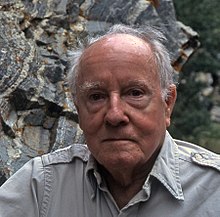Warren B. Hamilton
Warren Bell Hamilton (born May 13, 1925 in Los Angeles; † October 26, 2018 in Golden, Colorado) was a US geologist.
Hamilton graduated from the University of California, Los Angeles (UCLA) with a bachelor's degree in 1945 while serving military service as an officer in the U.S. Navy. In 1951, he received his doctorate in geology from UCLA. In 1951/52 he was Assistant Professor at the University of Oklahoma, and from 1952 he did research for the US Geological Survey, with which he remained until retirement in 1996 (latterly as Senior Scientist). He was then Distinguished Senior Scientist at the Colorado School of Mines.
He was concerned with plate tectonics, marine geophysics, evolution of crust and mantle, petrology of igneous and metamorphic rocks, tectonics of the western USA (including the batholiths of the Sierra Nevada), but also of Southeast Asia, Indonesia, Melanesia, the Soviet Union (where he was an exchange scientist in 1967), and Antarctica, where he was in 1958/59 and 1963/64 and found evidence in the Transantarctic Mountains of common Gondwana structures with South Africa and Australia (Adelaide Geosyncline).
With the advent of plate tectonics in the 1960s (then based on marine geology), he applied this to explain continental tectonics in, for example, California, where he recognized the separation of Baja California along the St. Andrew Fault from Mexico. From 1969 he investigated the geology of Indonesia plate tectonically (motivated in part by oil exploration), combining offshore geology and onshore investigations. This investigation of Indonesia also brought new insights into the mechanism of plate tectonics.
From the 1970s to the 1990s he worked on the evolution of the Earth's crust in the Phanerozoic and carried out field studies worldwide. He then extended his observations to other planets and the first 4 billion years of the Earth, whereby he took a different view to the conventional picture of plate tectonics. Whereas mantle convection and plume were usually assumed to be the driving forces of plate tectonics, Hamilton assumed a picture of surface cooling of the Earth's hot interior and sinking plates as the driving forces. Volcanism in the middle of plates, as in Hawaii, usually attributed to plumes, he saw as resulting from weaknesses in the Earth's crust in that area. Convection he saw as confined to the upper mantle (above the 660-km discontinuity). He also took a different view of geological processes in the Archean and Proterozoic, seeing rocks only in the late Proterozoic (from an age of 800 million years) that could be interpreted as the result of the usual plate tectonic processes of the Phanerozoic. Likewise, he rejected a formation by plate tectonics on Mars and Venus.
He was a visiting professor at the University of Amsterdam in 1981, at Caltech in 1973, at the Scripps Institute of Oceanography in 1968 and 1979, and at Yale University in 1980.
In 1989 he received the Penrose Medal. He was a member of the Geological Society of America, the National Academy of Sciences, and the American Association for the Advancement of Science. The Hamilton Cliff in Antarctica bears his name.
He was married to Alicita Koenig (marriage 1947) and had three children with her.

Warren Hamilton, Colorado 2007
Search within the encyclopedia